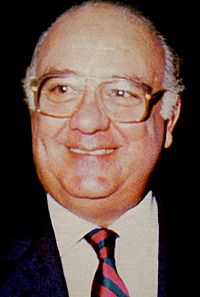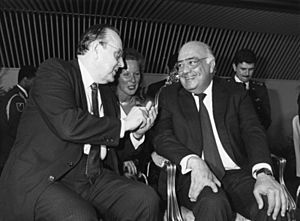Jaime Lusinchi facts for kids
Quick facts for kids
Jaime Lusinchi
|
|
|---|---|
 |
|
| President of Venezuela | |
| In office 2 February 1984 – 2 February 1989 |
|
| Preceded by | Luis Herrera Campins |
| Succeeded by | Carlos Andrés Pérez |
| Senator for life | |
| In office 2 February 1989 – 13 August 1993 |
|
| In office 1998–1999 |
|
| Personal details | |
| Born |
Jaime Ramón Lusinchi
27 May 1924 Clarines, Anzoátegui, Venezuela |
| Died | 21 May 2014 (aged 89) Caracas, Venezuela |
| Political party | Acción Democrática |
| Spouses |
Gladys Castillo
(m. 1941; div. 1988)Blanca Ibáñez
(m. 1991) |
| Alma mater | Central University of Venezuela |
| Occupation | Physician |
| Signature | |
| Website | Official website: https://web.archive.org/web/20100329055814/http://www.jaimelusinchi.org/ |
Jaime Ramón Lusinchi (born May 27, 1924 – died May 21, 2014) was a Venezuelan politician. He served as the president of Venezuela from 1984 to 1989. During his time as president, Venezuela faced some economic challenges. Even with these challenges, he was quite popular with the people. After his term, another member of his political party, Carlos Andrés Pérez, became president.
Contents
Early Life and Education
Jaime Lusinchi was born in Clarines, Anzoátegui, Venezuela, on May 27, 1924. His mother, María Angelica Lusinchi, gave him her family name. He went to elementary school in his hometown and in Puerto Píritu. He then attended high school in Barcelona, Anzoátegui.
In 1941, he started studying medicine at the University of the Andes in Mérida. He later moved to Caracas and finished his medical degree at the Central University of Venezuela in 1947. He married Gladys Castillo in 1941.
Starting a Political Career
Jaime Lusinchi became interested in politics at a young age. When he was 13, in 1937, he joined the National Democratic Party. This group was formed by Rómulo Betancourt to oppose the government at the time. In 1941, Lusinchi helped start the social democratic party called Acción Democrática.
While in college, Lusinchi was a very active student leader. He was involved in several student groups. These groups were part of a movement that led to a change in government in 1945. After college, he held important political roles in his home state of Anzoátegui.
Facing Challenges and Exile
In 1948, Venezuela's first elected leader, Rómulo Gallegos, was removed from power by the military. Lusinchi continued his political work secretly. He had to hide from the new military government and was arrested several times. He even worked in a hospital for a while to avoid being caught.
He later moved to Caracas and joined the secret organization of his party, Acción Democrática. They worked to resist the military rule. In 1950, he helped organize a big strike for oil workers. After a problematic election in 1952, a new dictatorship began under Marcos Pérez Jiménez. Lusinchi was arrested again and spent time in prison.
After his release, he went into exile for five years. He lived in Argentina, Chile, and the United States. During his time in Buenos Aires and Santiago, he studied Pediatrics. He also made friends with important political figures in Chile. In 1956, he moved to New York City, where many leaders of his party were living in exile. There, he earned a master's degree in pediatrics.
Return to Venezuela and Presidency
In 1958, democracy returned to Venezuela. Lusinchi came back from exile and joined the national leadership of Acción Democrática. In the 1959 elections, he was elected as a representative for Anzoátegui in the National Congress. He was re-elected several times.
In 1977, Lusinchi tried to become the president of his party but was not successful. In the 1978 elections, he was defeated as a presidential candidate. However, he was later elected as a senator. In 1981, he became the General Secretary of Acción Democrática. On June 29, 1982, he was chosen as the party's candidate for the 1983 presidential elections.
On December 4, 1983, Jaime Lusinchi won the presidency with 56% of the votes. His party also gained a majority in Congress. On February 2, 1984, he officially became the President of Venezuela for a five-year term.
Presidency of Jaime Lusinchi

President Lusinchi began his term at age 59. He promised to lead with fairness and to use public money wisely. He aimed to be a moderate leader.
The first three years of his presidency focused on making the economy stable. His government tried to pay off foreign debts and reduce government spending. They also worked on social programs to help people and encourage industrial growth. While not all goals were met, agriculture and iron mining did grow. Venezuela's economy also saw positive growth rates by the end of 1984.
His government worked to manage Venezuela's large foreign debt. This debt, which was money owed to other countries and banks, was about 36 billion dollars in 1985. These efforts helped Venezuela regain a good credit rating. Lusinchi also worked with OPEC to try and increase oil prices.
| Venezuelan Presidential election 1983 | |||||||||||||||||||||
| Results [1] | |||||||||||||||||||||
|
|||||||||||||||||||||
However, the oil market was unpredictable, and oil prices were low. Venezuela's economy relied heavily on oil. This made it hard to pay off the debt, which was a major promise Lusinchi made.
In 1985, there was a period of social peace. This was partly because the country's largest trade union supported the government. During this year, President Lusinchi welcomed John Paul II, who was the first Pope to visit Venezuela.
Later in his presidency, social tensions grew. The government decided to change its economic policies. In December 1986, the value of the national currency, the bolivar, was changed. By 1987, Lusinchi stopped his earlier economic plans. He gave up on trying to pay off the foreign debt and control government spending.
After this, Lusinchi's government increased salaries and controlled prices. These actions aimed to calm social tensions. While these measures helped keep Lusinchi popular, they also led to higher prices for goods and services.
Lusinchi supported Carlos Andrés Pérez to be the next president. Pérez won the election in 1988. Lusinchi's term ended on February 2, 1989.
Pope John Paul II Visits Venezuela
In January 1986, Pope John Paul II made a historic visit to Venezuela. It was the first time a Pope had ever visited the country. Thousands of people came together for cultural and religious events in several cities, including Puerto Ordaz, Maracaibo, Mérida, and Caracas. A housing complex was later built in Caracas to remember where the Pope held a large Mass.
Caldas Incident
On August 13, 1987, a Colombian navy ship, the Caldas, sailed into the Gulf of Venezuela. This caused a serious disagreement between Colombia and Venezuela. It almost led to a conflict. However, President Lusinchi and Colombian President Virgilio Barco talked things over, and the issue was resolved peacefully.
Personal Life Changes
In 1988, President Lusinchi and his wife, Gladys Castillo, divorced. They had been married for 44 years. This was the first time a Venezuelan president had divorced while in office. The Catholic Church in Venezuela expressed its disapproval of the divorce.
Later Life and Passing
After his presidency, Lusinchi became a Senator for Life, as allowed by the Venezuelan constitution. He later moved to Miami and then to Costa Rica. He married Blanca Ibáñez in 1991. In 2009, he returned to Caracas.
Jaime Lusinchi passed away on May 21, 2014, at the age of 89. He had been in the hospital for lung problems.
See also
 In Spanish: Jaime Lusinchi para niños
In Spanish: Jaime Lusinchi para niños
- List of Venezuelans
- Presidents of Venezuela
Images for kids

